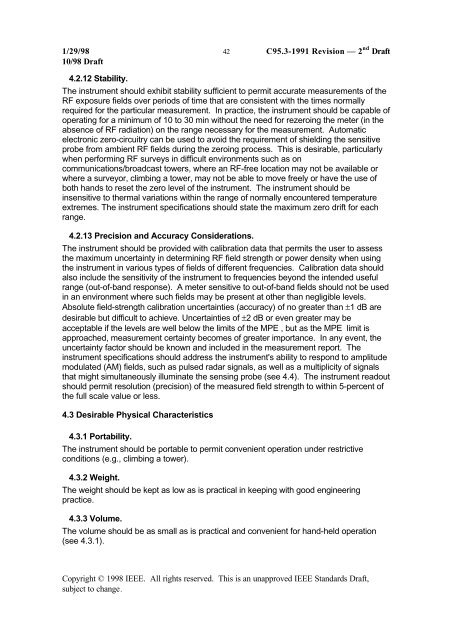DRAFT Recommended Practice for Measurements and ...
DRAFT Recommended Practice for Measurements and ...
DRAFT Recommended Practice for Measurements and ...
You also want an ePaper? Increase the reach of your titles
YUMPU automatically turns print PDFs into web optimized ePapers that Google loves.
1/29/98 42 C95.3-1991 Revision — 2 nd Draft<br />
10/98 Draft<br />
4.2.12 Stability.<br />
The instrument should exhibit stability sufficient to permit accurate measurements of the<br />
RF exposure fields over periods of time that are consistent with the times normally<br />
required <strong>for</strong> the particular measurement. In practice, the instrument should be capable of<br />
operating <strong>for</strong> a minimum of 10 to 30 min without the need <strong>for</strong> rezeroing the meter (in the<br />
absence of RF radiation) on the range necessary <strong>for</strong> the measurement. Automatic<br />
electronic zero-circuitry can be used to avoid the requirement of shielding the sensitive<br />
probe from ambient RF fields during the zeroing process. This is desirable, particularly<br />
when per<strong>for</strong>ming RF surveys in difficult environments such as on<br />
communications/broadcast towers, where an RF-free location may not be available or<br />
where a surveyor, climbing a tower, may not be able to move freely or have the use of<br />
both h<strong>and</strong>s to reset the zero level of the instrument. The instrument should be<br />
insensitive to thermal variations within the range of normally encountered temperature<br />
extremes. The instrument specifications should state the maximum zero drift <strong>for</strong> each<br />
range.<br />
4.2.13 Precision <strong>and</strong> Accuracy Considerations.<br />
The instrument should be provided with calibration data that permits the user to assess<br />
the maximum uncertainty in determining RF field strength or power density when using<br />
the instrument in various types of fields of different frequencies. Calibration data should<br />
also include the sensitivity of the instrument to frequencies beyond the intended useful<br />
range (out-of-b<strong>and</strong> response). A meter sensitive to out-of-b<strong>and</strong> fields should not be used<br />
in an environment where such fields may be present at other than negligible levels.<br />
Absolute field-strength calibration uncertainties (accuracy) of no greater than ±1 dB are<br />
desirable but difficult to achieve. Uncertainties of ±2 dB or even greater may be<br />
acceptable if the levels are well below the limits of the MPE , but as the MPE limit is<br />
approached, measurement certainty becomes of greater importance. In any event, the<br />
uncertainty factor should be known <strong>and</strong> included in the measurement report. The<br />
instrument specifications should address the instrument's ability to respond to amplitude<br />
modulated (AM) fields, such as pulsed radar signals, as well as a multiplicity of signals<br />
that might simultaneously illuminate the sensing probe (see 4.4). The instrument readout<br />
should permit resolution (precision) of the measured field strength to within 5-percent of<br />
the full scale value or less.<br />
4.3 Desirable Physical Characteristics<br />
4.3.1 Portability.<br />
The instrument should be portable to permit convenient operation under restrictive<br />
conditions (e.g., climbing a tower).<br />
4.3.2 Weight.<br />
The weight should be kept as low as is practical in keeping with good engineering<br />
practice.<br />
4.3.3 Volume.<br />
The volume should be as small as is practical <strong>and</strong> convenient <strong>for</strong> h<strong>and</strong>-held operation<br />
(see 4.3.1).<br />
Copyright © 1998 IEEE. All rights reserved. This is an unapproved IEEE St<strong>and</strong>ards Draft,<br />
subject to change.
















